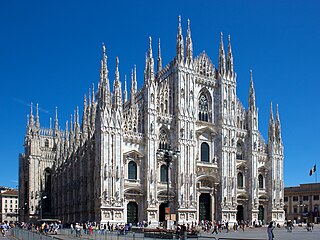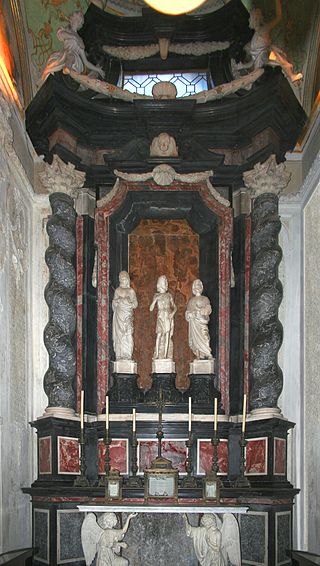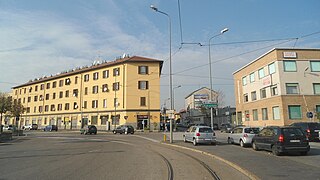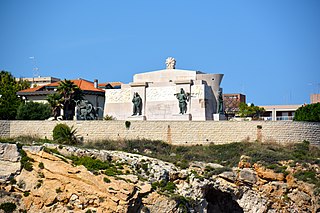
Milan Cathedral, or Metropolitan Cathedral-Basilica of the Nativity of Saint Mary, is the cathedral church of Milan, Lombardy, Italy. Dedicated to the Nativity of St. Mary, it is the seat of the Archbishop of Milan, currently Archbishop Mario Delpini.

The Chigi Chapel or Chapel of the Madonna of Loreto is the second chapel on the left-hand side of the nave in the Basilica of Santa Maria del Popolo in Rome. It is the only religious building of Raphael which has been preserved in its near original form. The chapel is a treasure trove of Italian Renaissance and Baroque art and is ranked among the most important monuments in the basilica.

The Victor Emmanuel II National Monument, also known as Vittoriano or Altare della Patria, is a large national monument built between 1885 and 1935 to honour Victor Emmanuel II, the first king of a unified Italy, in Rome, Italy. It occupies a site between the Piazza Venezia and the Capitoline Hill. The monument was realized by Giuseppe Sacconi.

The Certosa di Pavia is a monastery and complex in Lombardy, Northern Italy, situated near a small town of the same name in the Province of Pavia, 8 km (5.0 mi) north of Pavia. Built in 1396–1495, it was once located on the border of a large hunting park belonging to the Visconti family of Milan, of which today only scattered parts remain. It is one of the largest monasteries in Italy.
Luigi Acquisti (1745–1823) was an Italian sculptor mainly known for his works in the neoclassical style.

The Church of the Gesù, known also as the Saint Mary of Jesus or the Casa Professa, is a Baroque-style, Roman Catholic church established under the patronage of the Jesuit order, and located at Piazza Casa Professa 21 in Palermo, region of Sicily, Italy.

The Piccolomini Altarpiece is an architectural and sculptural altarpiece in the left-nave of Siena Cathedral, commissioned by cardinal Francesco Todeschini Piccolomini who expected it to become his tomb. However, he was elected Pope Pius III and buried in the Vatican. It was built between 1481 and 1485 by Andrea Bregno in Carrara marble, with additions in the following decades – these included four niche sculptures produced between 1501 and 1504 by Michelangelo of saints Peter, Augustine, Paul and Gregory. On top of the altar is the Madonna and Child, a sculpture (probably) by Jacopo della Quercia. The central painting of the Madonna is by Paolo di Giovanni Fei and from the late 14th century.

Grazioso Rusca was a Swiss sculptor who was also active in northern Italy.

Quartiere Varesina is a small district, quartiere, of Milan, located in the suburban north-west part of the city. It belongs on the Zone 8 administrative division of the city.
Musocco is a district of Milan, located in the north-western outskirts of the city, belonging to Zone 8.

The Monument of Piazza Mentana or Monument to those fallen at the Battle of Mentana is an early-20th century outdoor bronze statue located the said square of Florence, Italy. The monument displays two patriotic fighters of Garibaldi's units, one wounded, the other fighting, in a dramatic scene.

The Monument to Giovanni delle Bande Nere is an Italian Renaissance sculpture in marble, by Baccio Bandinelli and his workshop, now in Piazza San Lorenzo in Florence, Tuscany, Italy. The work took from 1540 to after 1560 to carve, and the base and statue, though always meant to be together, were only so placed in 1850.
Luigi Fabris was an Italian sculptor and ceramist.

The Arco della Vittoria, also known as Monumento ai Caduti or Arco dei Caduti, is a memorial arch located in Piazza della Vittoria in Genoa, Italy. It is dedicated to the Genoese who died during World War I, and it was inaugurated on 31 May 1931.

The Monumento ai Caduti is a Fascist era monument located in the center of Piazza San Francesco in Pistoia, region of Tuscany, Italy. The monument was meant to recall those fallen in the battles of World War I between 1915 and 1918. While completed some years before, the bronze statue was only installed in 1926 with the King in attendance. The bronze statue depicts a muscular, semi nude, semi-recumbent man sheltering a statue of victory as he glares to the distance. The statue is on a marble base with flanking bas-reliefs depicting a Winged victory and a mother and child sharing bundles of wheat (fasce). The sculptor, Silvio Carnevari (1891-1953) would go on to sculpt depictions of athletes for the Stadio Mussolini in Rome. Many of this statues, including The Pugilist and his Monument to Victory at Civita Castellana, also focus on the athletic man in combat.
Formia War Memorial is an Italian war memorial erected in 1926 to commemorate the dead of the First World War and earlier conflicts. It stands in the Piazza della Vittoria, in the centre of Formia, a town on the coast of the Province of Latina beside the Tyrrhenian Sea, about 150 km (93 mi) southeast of Rome and 100 km (62 mi) northwest of Naples

The Monument to the Fallen Italians in Africa is a Fascist era monument, dedicated to the Italians who died during the Ethiopian War (1935-1936), and assembled only in the 1960s on the seashore in Siracusa, region of Sicily, Italy. The monument, sculpted and designed by Romano Romanelli, was initially meant to be shipped in 1940 and assembled in Addis Ababa in Ethiopia; however, the Second World War prevented the transport, and led to its installation more than two decades later at this site, chosen because Syracuse had been a center for embarcation of troops for the African wars.

The Statue of Asmus Jacob Carstens is a statue of German-Danish painter Asmus Jacob Carstens situated in the garden of the Ny Carlsberg Glyptotek, facing Niels Brocks Gade, in Copenhagen, Denmark. It was created by Theobald Stein in 1878–1879 and moved to its current location in 1894. It is complemented by a statue of Georg Zoëga facing Tietgensgade on the other side of the museum. The monument is flanked by two other bronze statues, Jules Dalou's Field Worker /1893) and Constantin Meunier's The Hammerman-

The Monument to the Fallen is a Fascist era monument, dedicated to the Italians who died during the First World War (1915-1918), and located in central Reggio Emilia, at the south border of the Parco del Populo, at the border with Piazza della Vittoria and just west of the town's Opera House.

Piazzale Loreto massacre was a Nazi-Fascist massacre that took place in Italy, on 10 August 1944 in Piazzale Loreto, Milan, during the World War II.






















